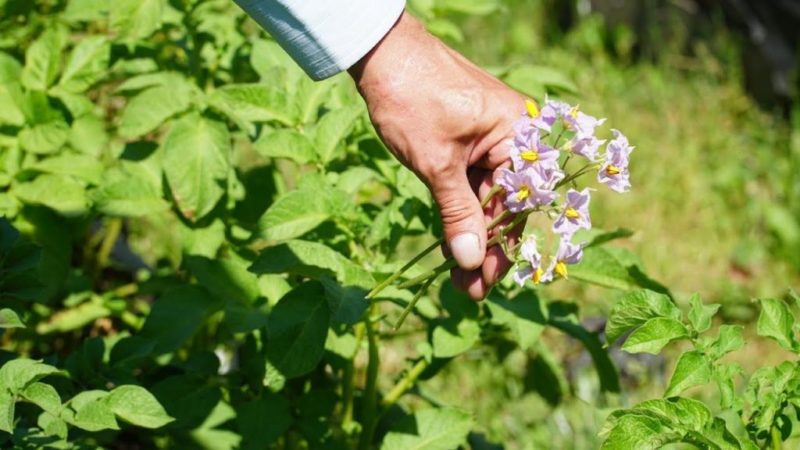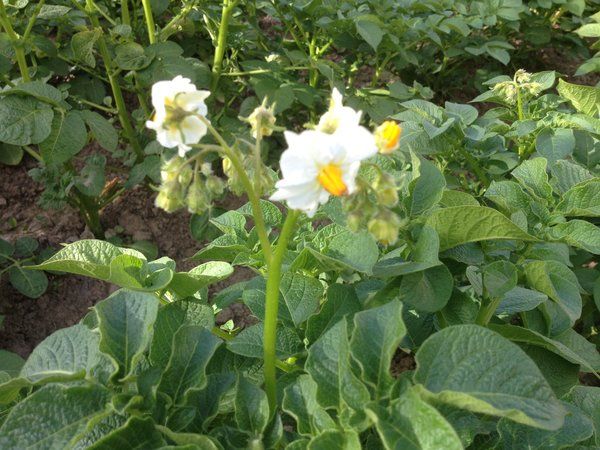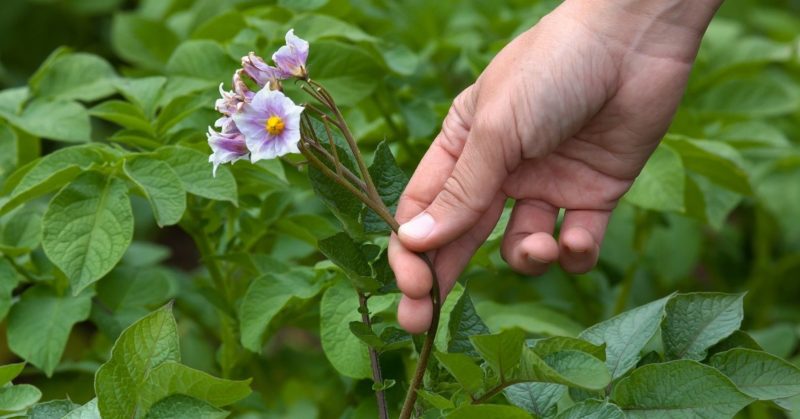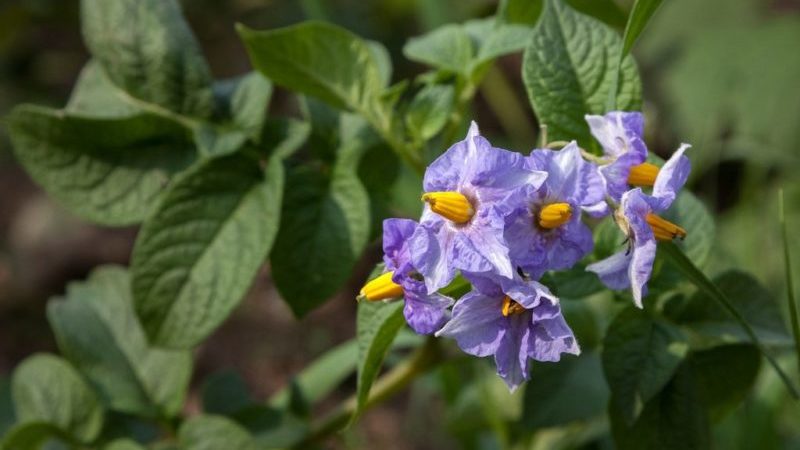Life hacks of experienced farmers: why pick flowers from potatoes and what does it give
For more than one generation, gardeners have been arguing about whether it is necessary to remove flower stalks on potatoes. Breeders develop varieties with a short flowering phase and few buds.
Experienced farmers will help you understand this issue by telling you whether you need to pick off inflorescences from potatoes, how best to do it so as not to harm the plant and get a good harvest.
The content of the article
Do I need to pick flowers from potatoes
Gardeners constantly argue about the advisability of removing peduncles. Let's consider the issue from a biological point of view.

Why do it, what does it give
Potatoes propagates by seeds, which are formed after flowering, and vegetatively - with the help of tubers.
After the emergence of seedlings, an active growth of the green mass of the bushes begins. And under the soil layer, colorless thin shoots are formed - stolons, at the ends of which tubers are subsequently formed.
About a month and a half after germination, the potatoes release buds. In early varieties this happens after 27-35 days, in later varieties - after 46-48 days. By the time of flowering, individual tubers reach the size of a pea, and in some varieties - a chicken egg.
Research by agricultural scientists led to the conclusion that the bush spends 45 to 50% of nutrients on the development of root crops, 25% goes to the leaves and 25% is required for flowering and seed ripening. This fact became the main argument for removing peduncles.
By picking off flowers on potatoes, farmers exclude one of the links in nutrient consumption: the plant enters the phase of active vegetation, the bush begins to grow additional stolons, and, accordingly, new ones tubers.
Reference. Before flowering potatoes, loosen the soil, this will allow the stolons to grow more freely and actively.
The number of green shoots and leaves also increases, which helps the plant get more energy through photosynthesis. The growing season also lengthens. In central Russia, potato bushes may not bog down until September. With well-organized care and preventive protection against late blight, plants are able to increase the mass of tubers for a long time.
What is the connection between flowering and yield

Experiments carried out by farmers have shown that in most potato varieties, cutting off the peduncles leads to an increase in the number of tubers on the bush and an increase in yield.
The essence of the experiment:
- the area with planted potatoes is divided into two parts; the plants are treated equally.
- in the first section, all inflorescences are removed, and in the second, the plants are given the opportunity to actively bloom and form berries with seeds.
- after harvesting potatoes, control weighing of tubers is carried out.
According to the results of the experiment, from the first plot, the total mass of tubers was 20% higher than in the control plot, where the flowers were not cut and the seeds ripened.
Studies have also shown that removing the buds increases the starchiness of the tubers by 0.8 - 2.5%. This significantly improves the taste of potatoes.
When to pick flowers

The period of removal of inflorescences is considered important from the point of view of yield for a plant.
The farmers noticed the following fact. If you remove the buds from a potato, then the plant seeks to quickly restore them, actively increasing new ones in an effort to set seeds... It spends a significant amount of nutrition and energy on this process to the detriment of the formation of stolons and the growth of the size of tubers.
Remove flower stalks only when the flowers are already blooming on them. The potato, like the tomato, is a self-pollinated plant. When the pollination process has passed and ovaries have begun to form, the plant receives a hormonal signal about this. It stops spending energy on budding and completely goes over to vegetative reproduction.
How to do it right

Incorrectly or untimely cut inflorescences can lead to the development of a fungal or viral infection. Follow the rules:
- Choose evening, dry and calm weather for removing flowers.
- Prepare sharp garden tools for cutting - a knife or scissors. Do not break off the peduncles with your hands, since a large wound surface heals for a long time, which significantly increases the risk of plant infection, and the sap smell attracts pests.
- Remove flowers with utmost care so as not to harm the plants. Cut off the entire flower cluster, not individual buds or flowers.
- Move carefully around the field, taking care not to damage the plants or compact the soil if it is wet.
If the moment of pruning is missed and the plant has already bloomed, remove the emerging berry ovaries, preventing them from taking food from the bush.
What happens if you don't pick flowers

If you do not cut the flower stalks, you will not get a 20% increase in potato yield. This is especially true for the following situations:
- if the soil under the potatoes is dense and poor, the tubers will not have enough nutrients;
- if there is a lack of moisture in dry areas.
It is difficult to carry out the peduncle removal procedure in large farm fields. They use other means to increase crop yields. As a rule, these are intensive fertilizers with the help of minerals.
However, it is not difficult to cut flowers in small areas as an environmentally friendly way to increase yields, and the result will please.
Interesting fact. In ancient times, cutting off flowers was dictated by safety requirements. In Europe, potatoes were originally grown as a beautifully flowering ornamental plant - sometimes people ate its berries, not knowing that they were poisonous.
Tips & Tricks
Experienced farmers on their plots have repeatedly pruned the peduncles of potatoes and share their recommendations:
- Before carrying out the procedure, prepare a disinfectant solution and periodically treat the blades with it in order to exclude the transmission of diseases and fungi through the garden tool.
- Do not cut flower stalks in cold weather and during periods of high humidity - this way you risk creating favorable conditions for the development of late blight.
- In parallel with removing flowers, inspect the bushes for pests and diseases. Prepare a jar in advance for collecting the Colorado potato beetle or its larvae - during the flowering period, it often attacks potatoes.
Reviews
Reviews of summer residents from different regions indicate that, if applied correctly, the method works:
Irina, Vologda: “When growing potatoes, I once tried to pick flowers. The variety is constantly planting the same. It usually grows on 12-15 tubers. She plucked flowers in half of the planted rows. In the fall, I discovered that on one bush, where the flowers were torn off, 20 root crops were formed, although a little smaller than always. I was satisfied. "
Stanislav, Tula: “Last year I decided to cut the flowers of the potatoes into pieces of boletus. During the digging, he noted that there were more tubers in these rows than usual. The cutting process itself is not difficult, but it was hard to guess for good weather. It rained a lot. Next year I will try again to make sure that the yield is increasing with this method. "
It will be interesting:
Advantages and disadvantages of growing potatoes using Dutch technology
Conclusion
Removing flowers from potatoes allows the plant to devote all its energy to growing additional stolons and increasing tubers, which leads to an increase in crop yield. Pick off blooming and pollinated flowers with a sterile garden tool.